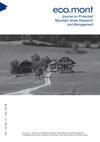波兰塔特拉国家公园旅游路线上的固体废物问题
IF 0.8
4区 环境科学与生态学
Q4 BIODIVERSITY CONSERVATION
Eco Mont-Journal on Protected Mountain Areas Research
Pub Date : 2020-01-01
DOI:10.1553/eco.mont-12-1s35
引用次数: 2
摘要
无论国家公园位于哪个国家,在旅游路线上留下的垃圾都是一个长期存在的问题。本文分析了波兰最受欢迎的自然公园——塔特拉国家公园(Tatra National park, TNP)的旅游步道上的垃圾数量。塔特拉国家公园是一个小面积的山区,游客大量使用。使用塔特拉步道的游客每年在那里留下140到180立方米的固体废物。它出现在公园里,而且很难看,对动植物来说是一个潜在的风险。从TNP小径收集的废物中有90%是硬质或不可生物降解的废物。从TNP的游客路线产生的废物需要作为一个整体来考虑,因为可回收的部分约占所有垃圾的70%,因此TNP等地区应该受到有组织的废物管理。研究发现,实施的特定策略显著影响了实际收集和处理的旅游路线废物的数量。废物管理战略有效运作的关键因素是一贯地执行一项行动计划,该计划考虑到该地区的具体性质以及向游客提供该地区的原则。尤其重要的是垃圾清除的频率和规律性。此外,有必要提高公众对TNP游客小径上留下的废物的认识。配置文件本文章由计算机程序翻译,如有差异,请以英文原文为准。
The problem of solid waste on the tourist trails of Tatra National Park, Poland
Litter left behind on tourist trails is a persistent problem in national parks, regardless of the country in which the park is situated. The present article analyses the amount of waste on tourist trails in the most popular natural park in Poland, Tatra National Park (TNP), a small area of a mountainous character which is heavily used by tourists. Tourists who use the Tatra trails leave from 140 to 180 m3 solid waste there per year. Its presence in parks, as well as being unsightly, is a potential risk for fauna and flora. 90% of the waste collected from the trails in TNP is hard or non-biodegradable waste. The waste from TNP’s tourists trails needs to be considered in its totality, as recyclable fractions make up about 70% of all rubbish disposed of, and so areas such as TNP should be subject to organized waste management. It was found that the particular strategy implemented significantly affects the amount of waste from the tourist trails that is actually collected and disposed of. The key element for the efficient functioning of the waste-management strategy is the consistent implementation of an action plan that takes into account the specific nature of the area and the principles under which it is made available to tourists. Particularly significant are the frequency and regularity with which rubbish is removed. Moreover, there is a need to raise public awareness regarding waste left on tourists trails in TNP. Profile
求助全文
通过发布文献求助,成功后即可免费获取论文全文。
去求助
来源期刊

Eco Mont-Journal on Protected Mountain Areas Research
BIODIVERSITY CONSERVATION-ECOLOGY
CiteScore
1.20
自引率
0.00%
发文量
1
审稿时长
>12 weeks
期刊介绍:
eco.mont offers a platform specifically for scientists and practitioners working in and on protected mountain areas in Europe and overseas.Target audiences of the journal are scientists from all related disciplines, managers of protected areas and an interested public including practitioners, visitors, teachers, etc.
 求助内容:
求助内容: 应助结果提醒方式:
应助结果提醒方式:


